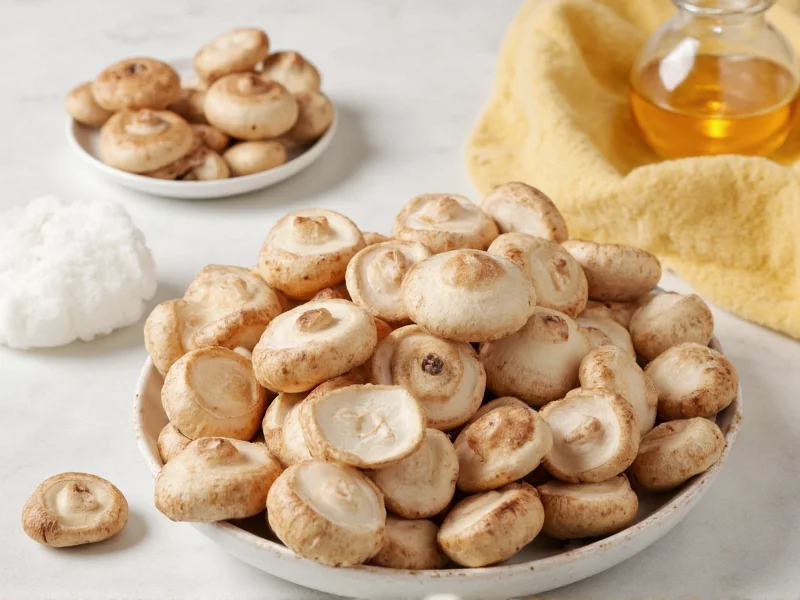Button mushrooms represent approximately 90% of all mushrooms consumed globally, yet many people overlook their impressive nutritional profile. Understanding button mushroom nutritional value reveals why these humble fungi deserve a regular place in your meal planning. Unlike more exotic varieties, button mushrooms offer exceptional nutritional benefits at an accessible price point, making them ideal for everyday cooking.
Nutritional Breakdown of Button Mushrooms
Per 100g raw button mushrooms (about 5 medium mushrooms), the nutritional facts for button mushrooms include:
| Nutrient | Amount | % Daily Value* |
|---|---|---|
| Calories | 22 | 1% |
| Protein | 3.1g | 6% |
| Carbohydrates | 3.3g | 1% |
| Dietary Fiber | 1.0g | 4% |
| Sugars | 2.0g | - |
| Fat | 0.3g | 0% |
| Vitamin D (when UV-exposed) | 5.6mcg | 28% |
| Riboflavin (B2) | 0.4mg | 31% |
| Niacin (B3) | 3.6mg | 23% |
| Pantothenic Acid (B5) | 1.5mg | 30% |
| Selenium | 13.9mcg | 25% |
| Potassium | 318mg | 7% |
*Percent Daily Values based on a 2,000 calorie diet. Values may vary based on growing conditions and UV exposure.
Key Health Benefits of Button Mushrooms
The health benefits of button mushrooms extend far beyond their basic nutritional content. Research published in Nutrients journal confirms that regular mushroom consumption correlates with reduced inflammation markers and improved immune function. Button mushrooms contain two powerful antioxidants—ergothioneine and glutathione—that work synergistically to protect cells from oxidative damage.
One particularly valuable aspect of button mushroom vitamin content is their ability to provide vitamin D when exposed to ultraviolet light. Unlike most plant foods, mushrooms can synthesize vitamin D2 when exposed to sunlight or artificial UV radiation. Many commercial growers now implement UV treatment to boost vitamin D levels, transforming button mushrooms into one of the few non-animal food sources of this essential nutrient.
Button Mushrooms vs. Other Varieties
Many consumers wonder how button mushroom nutrition compares to cremini or portobello mushrooms. The truth is these are all the same species (Agaricus bisporus) at different maturity stages. Button mushrooms are the youngest form, followed by cremini (baby bella), then portobello (mature). While nutritional differences exist, they're relatively minor:
- Button mushrooms contain slightly more water and fewer calories per gram than mature varieties
- Portobello mushrooms have marginally higher fiber content due to their maturity
- All three forms provide similar vitamin and mineral profiles
- Flavor intensity increases with maturity, but nutritional density remains comparable
When evaluating white button mushroom nutritional advantages, their primary benefit lies in availability and affordability while still delivering substantial nutritional value.
Preservation Methods and Nutrient Retention
How you prepare button mushrooms significantly impacts their nutritional value of cooked button mushrooms. Research from the University of Illinois demonstrates that certain cooking methods preserve nutrients better than others:
- Grilling or microwaving preserves the highest levels of antioxidants
- Boiling causes the most significant nutrient loss, particularly water-soluble vitamins
- Stir-frying with minimal oil retains most nutrients while enhancing absorption of fat-soluble compounds
- Drying concentrates nutrients by removing water but may degrade some heat-sensitive compounds
Interestingly, cooking actually increases the bioavailability of certain nutrients in button mushrooms. The heat breaks down cell walls, making minerals like selenium more accessible to your body. For maximum nutritional benefit, pair cooked button mushrooms with healthy fats to enhance absorption of fat-soluble nutrients.
Practical Dietary Integration
Incorporating button mushrooms into your diet offers a simple way to boost nutrient intake without dramatically changing eating habits. The protein content in button mushrooms makes them particularly valuable for plant-based diets, providing complete protein with all essential amino acids. Try these evidence-based strategies:
- Add finely chopped button mushrooms to ground meat dishes to reduce fat content while maintaining texture
- Use as a pizza topping instead of higher-calorie options
- Create a nutrient-dense mushroom broth by simmering stems with herbs
- Blend into sauces and gravies for added nutrition without altering flavor significantly
- Include raw in salads for a mild, earthy flavor and crisp texture
For those specifically seeking button mushrooms for vitamin D benefits, look for packages labeled "UV-treated" or "high vitamin D" at your grocery store. These have been exposed to ultraviolet light to boost their vitamin D2 content significantly.
Addressing Common Misconceptions
Several myths surround button mushroom nutrition. Contrary to popular belief, button mushrooms don't absorb significant amounts of toxins from soil when commercially grown. Reputable producers use controlled substrate materials that prevent contamination. Additionally, the notion that wild mushrooms are always more nutritious than cultivated varieties lacks scientific support—commercial button mushrooms provide consistent, reliable nutrition without the risks associated with foraging.











 浙公网安备
33010002000092号
浙公网安备
33010002000092号 浙B2-20120091-4
浙B2-20120091-4